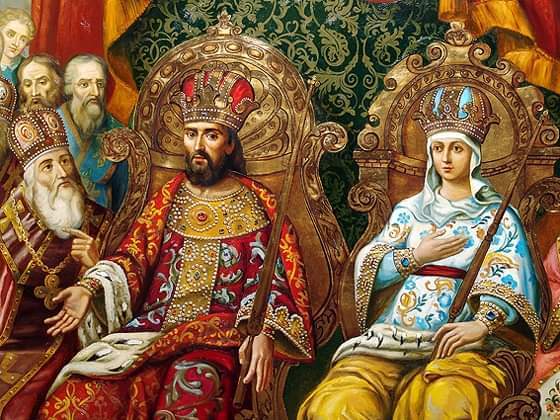Pulcheria was a devout Christian and at an early age she expressed her devotion to the Theotokos and took a vow of virginity to avoid being forced into marriage. As the elder sister of Theodosius II (her older sister, Flaccilla, died young, probably before 408), she held much of the power when he became emperor. She was involved extensively in the education of her brother even though she was only two years older than him and maintained enormous influence over him for much of his reign. Sources recorded that in 412 at the age of thirteen she dismissed her brother's tutor, Antiochus, and herself assumed the role of her brother's tutor.
The court quickly assumed a pious and austere atmosphere under her influence, befitting her almost monastic life style. On July 4, 414, the Senate proclaimed her Augusta (empress) and made her regent for her brother. When Theodosius became capable of ruling by himself in 416, Pulcheria continued to strongly influence over her brother and of the course of the empire. Through her influence Theodosius removed all pagans from the civil service. Under her influence Theodosius and his wife Aelia Eudoxia, who had been a pagan, became devout Christians.
Pulcheria used her wealth for the Church. In doing so she inspired her brother to do likewise. While she appeared to be indifferent to the Arianism as practiced by the German tribes, she took a firm position on the heretical teaching of Nestorius. She almost immediately showed her antagonism towards him when he became patriarch in 428. Whether the downgrading of the status of the Virgin Mary from Theotokos to Christotokos under Nestorianism was involved, Pulcheria greatly influenced her brother's position in the controversies that led up to the Council in Ephesus in 431. At first he was a supporter of Nestorius before acceding to his sister's position. In this controversy Patr. Cyril of Alexandria believed Pulcheria's influence was important in the downfall of his rival.
In 441, Pulcheria's influence on her brother began to wane as the eunuch Chrysaphius convinced Theodosius to dismiss his sister. But soon the Monophysite controversy was raised by the archimandrite Eutyches and supported by Theodosius as well as by Cyril's successor as patriarch of Alexandria, Dioscorus. When Eutyches' views were validated at the 'Robber Council' of 449 in Ephesus, Pope Leo I of Rome included Pulcheria among those he approached for help in reversing the council's decisions.
On July 28, 450, Theodosius suddenly died, and Pulcheria returned to the court as the wife of the new emperor, Marcian. She agreed to the marriage with the understanding that her vow of chastity would be honored. In 451, the Council of Chalcedon, presided over by Marcian, was convened. It condemned both Nestorianism and the Robber Council of 449 that had supported the Monophysite heresy. The heretic Eutyches was deposed and exiled.
Pulcheria died not long afterwards, in July 453. In addition to her defense of Orthodoxy, Pulcheria is remembered for her zeal in promoting other interests of the Church. She had the relics of St. John Chrysostom returned from where he had died in exile and buried in the Church of the Apostles in Constantinople on January 27, 438. She had three churches built in Constantinople that honored Mary the Theotokos. She built many hospitals, houses for pilgrims, and bequeathed her wealth to charity.

